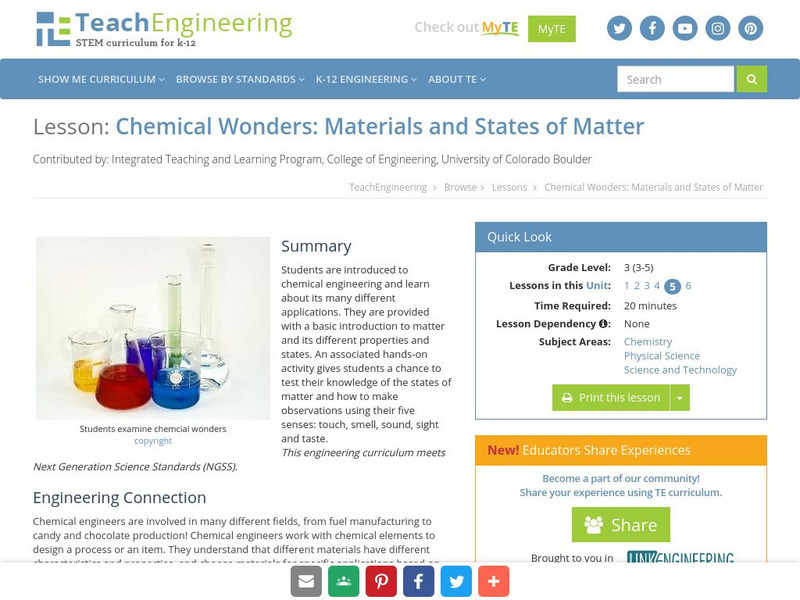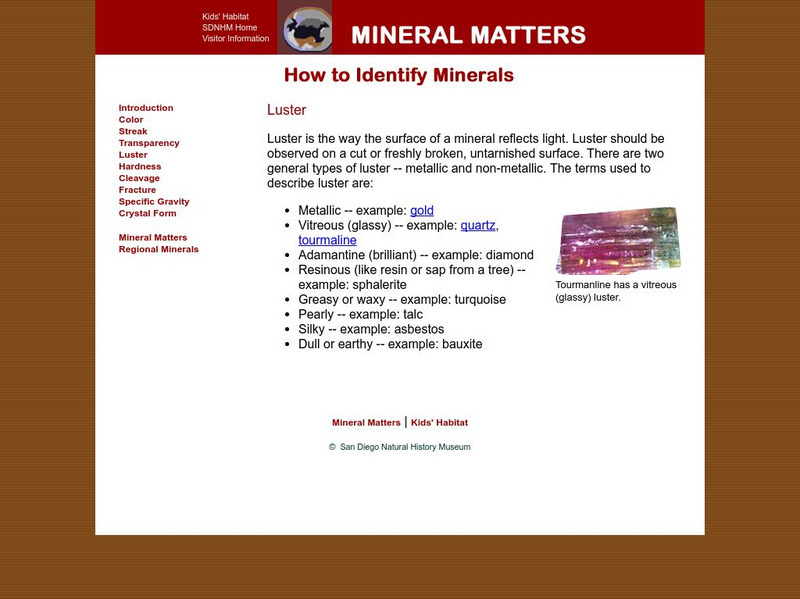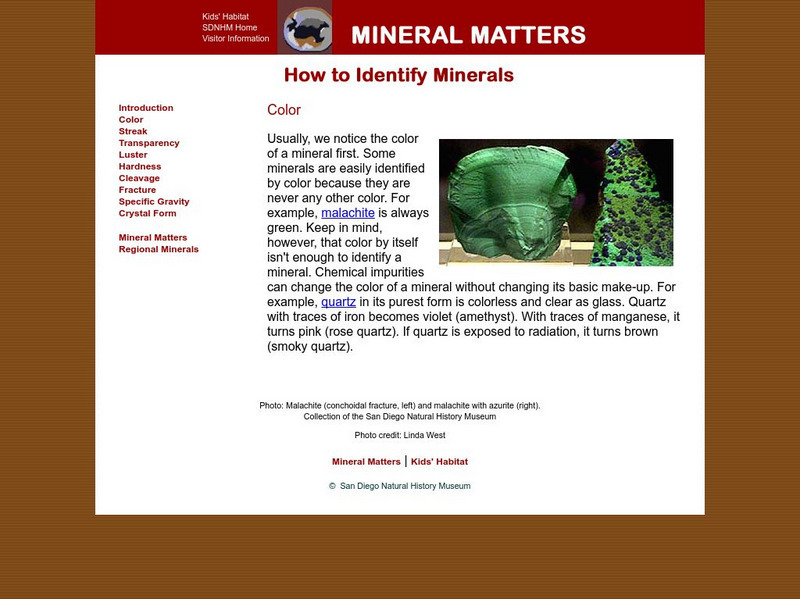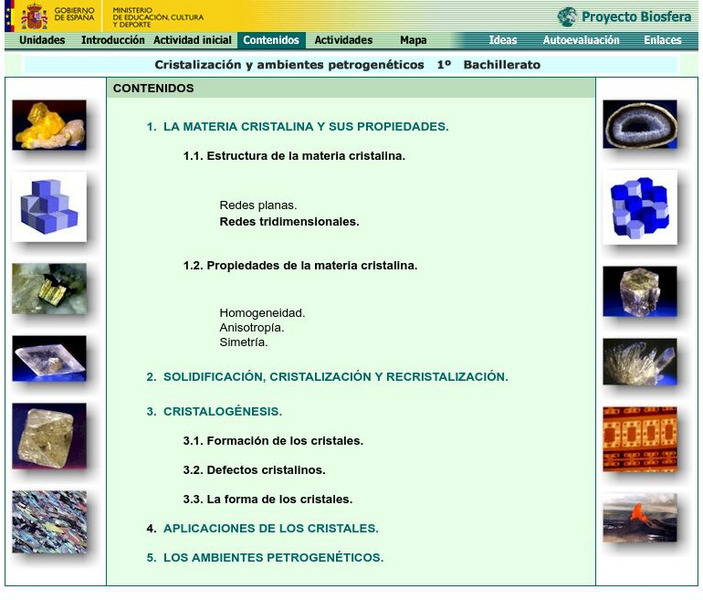Science Education Resource Center at Carleton College
Serc: Mystery Material: Is It a Solid or a Liquid?
Is it a solid or a liquid? In this activity, students will handle a mystery substance that has qualities of both a solid and a liquid while learning about phases. They will manipulate the substance, record any observations they...
TeachEngineering
Teach Engineering: Chemical Wonders
Students are introduced to chemical engineering and learn about its many different applications. They are provided with a basic introduction to matter and its different properties and states. An associated hands-on activity gives...
Science Education Resource Center at Carleton College
Serc: Mystery Material
Students will investigate an unknown material by determining its properties and categorizing its state of matter. They will observe how it behaves under different conditions, record their observations, analyze information, and be able to...
Council for Economic Education
Econ Ed Link: The Mystery of Is It Mine or Ours? (Educator Version)
Did you ride to school on a road today? Yesterday did you skate in a public park? Maybe Mom or Dad traveled home from one of your ball games on their bicycles under a string of street lights? How did the road, the park or the street...
Scholastic
Scholastic: Study Jams! Science: Matter: Periodic Table
A video and a short quiz on the periodic table of elements and how it is organized.
Chem Tutor
Chem Tutor: Chemistry: States of Matter
This lesson focuses on the states of matter: solids, liquids, and gases. It also discusses the Kinetic Theory of Matter, Thermodynamics, Triple point, Phase Change Graphs and the Heating Curve of Water. It provideds adrawing of a heating...
Science Education Resource Center at Carleton College
Serc: Air Is Matter
It's difficult at times for younger students to realize that air has mass. Matter is something that has volume (takes up space) and has mass (*can be weighed). Air does take up space, even if we can't see it, and air has weight, even if...
Simon Fraser University
Chem1 Virtual Textbook: The Measure of Matter
Find out all about units, measurements, and error when it comes to measuring matter.
ClassFlow
Class Flow: Introduction to Matter
[Free Registration/Login Required] This flipchart is a basic introduction to the properties of matter, mass, and weight. It discusses the physical properties of objects.
San Diego Natural History Museum
San Diego Natural History Museum: Mineral Matters: Luster
A brief introduction to identifying a mineral by its luster. Examples of terms used to describe luster, such as metallic, glassy, and dull are listed.
ClassFlow
Class Flow: Comparing and Contrasting Matter
[Free Registration/Login Required] This flipchart is a guided activity to help students compare different types of matter: atoms and molecules, elements and compounds, mixtures and solutions. It corresponds to Virginia science SOL 5.4.
San Diego Natural History Museum
San Diego Natural History Museum: Mineral Matters: Color
Don't be fooled! While color is one way to identify a mineral, it can often be misleading. Quartz is one example of a mineral that can change colors depending on its chemical make-up.
Alabama Learning Exchange
Alex: How Sweet It Is
As part of the study of Matter, the students will determine the density of standard percent sugar solutions through hands on experimentation. In laboratory groups, students will graph a standardized curve of the experimental data. The...
TeachEngineering
Teach Engineering: Measuring Viscosity
Students calculate the viscosity of various household fluids by measuring the amount of time it takes marble or steel balls to fall given distances through the liquids. They experience what viscosity means, and also practice using...
National Institute of Educational Technologies and Teacher Training (Spain)
Ministerio De Educacion: Cristalizacion Y Ambientes Petrogeneticos
This unit covers the crystalline matter and its properties. It includes 13 interactive activities.
NASA
Dawn Mission: Education: Structure and Properties of Matter: Ion Propulsion
Student groups explore propulsion technology necessary for the Dawn project to complete its mission. Learning module components include story mapping, online interactive activity, RAFT writing exercise, and other standards-aligned...
PBS
Pbs Learning Media: Atomic Structure
Take a look at the parts of an atom and learn about its properties.
US National Archives
Docsteach: The Titanic Disaster: Measuring Loss of Life, Property and Injuries
Learners will analyze claims filed by survivors, families of victims and owners of cargo of the Titanic disaster. They will examine claims for loss of life, loss of property and injuries that were filed as part of 'In the Matter of the...
American Chemical Society
Middle School Chemistry: What Is Density?
Calculate the density of cubes made of different materials to determine what type of material it contains. Using this information explain that the size, mass, and arrangement of the atoms or molecules of a substance determines its density.
Science Struck
Science Struck: Translucent, Transparent, and Opaque Materials
The definitions of transparent, translucent, and opaque can be found here. The article explains how the density of a material and its ability to absorb light determine which of these three properties it has. A list of examples is given...
American Chemical Society
Middle School Chemistry: Density: Sink and Float for Solids
Students determine whether an object will sink or float by comparing its density to the density of water.
New York University
New York University: States of Water
Use this resource to learn about the three different phases of water; solid, liquid, and gas. What happens to water as it changes into a solid or gas? Includes short and easy to do activity.
Science Education Resource Center at Carleton College
Serc: Plastic Polymers: Investigating Their Flexibility
Learners will use their prior knowledge about changes of matter to develop a hypothesis to test the physical properties of materials such as plastic (polymers) and how its chemical properties allow it to have unique physical properties.
Other
Science Alive: Melting Point Simulation
Percy Julian and Josef Pikl used the fact that melting point-the temperature at which a substance changes from a solid to a liquid-is a characteristic property of a substance to prove that the British chemist Robert Robinson could not...



















